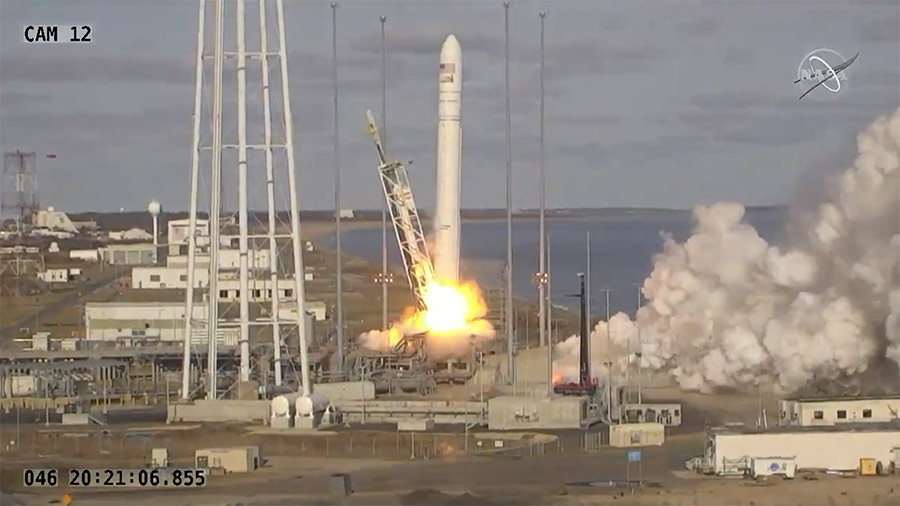
Northrop Grumman’s Cygnus resupply spacecraft is on its way to the station with approximately 7,500 pounds of science investigations and cargo after launching at 3:21 p.m. EST Saturday, Feb. 15 from NASA’s Wallops Flight Facility in Virginia. At the time of liftoff, the International Space Station was flying 258 statute miles over the western Pacific, northeast of the Northern Mariana Island.
The spacecraft launched on an Antares rocket from the Virginia Mid-Atlantic Regional Spaceport’s Pad 0A at Wallops. Automated command to initiate solar array deploy will begin at 4:40 p.m., about one hour and 19 minutes after launch. Solar array deployment will take about 30 minutes. Confirmation of solar deployment will be shared on the launch blog and social media at @NASA_Wallops and @space_station.
Cygnus is scheduled to arrive at the orbiting laboratory around 4:05 a.m. Tuesday, Feb. 18. Coverage of the spacecraft’s approach and arrival will begin at 2:30 a.m. on NASA Television and the agency’s website. NASA astronaut Andrew Morgan will use the space station’s robotic arm to capture Cygnus, while NASA’s Jessica Meir monitors telemetry. The spacecraft is scheduled to stay at the space station until May.
The spacecraft’s arrival brings more than 7,500 pounds of research and supplies to space station. Here are some of the scientific investigations:
Better Tissue and Cell Culturing in Space
Mobile SpaceLab, a tissue and cell culturing facility, offers investigators a quick-turnaround platform to perform sophisticated microgravity biology experiments. Such experiments are critical for determining how microgravity affects human physiology and identifying ways to mitigate negative effects. The platform can work in multiple configurations, allowing investigators to tailor the facility to their needs.
Mochii
The Mochii investigation provides an initial demonstration of a new miniature scanning electron microscope (SEM) with spectroscopy. Mochii will demonstrate real-time, on-site imaging and measurements of micro- and nanostructures aboard the space station. This capability could accelerate answers to many scientific inquiries and mission decisions and serve the public as a powerful and unique microgravity research platform.
Examining Bone Loss in Microgravity
Crew members experience bone loss in orbit, stemming from the lack of gravity acting on their bones. OsteoOmics investigates the molecular mechanisms that dictate this bone loss by examining osteoblasts, cells in the body that form bone, and osteoclasts, which dissolve bone. A better understanding of these mechanisms could lead to more effective prevention of astronaut bone loss during space missions.
Fighting Bacteria with Phages
Phage Evolution examines the effects of microgravity and radiation exposure on phage and bacterial host interactions, including phage specificity for a bacterial host and host resistance to specific phages. A better understanding of the effects of microgravity and cosmic radiation on bacteriophages and hosts could result in significant developments for phage technology, ultimately helping protect the health of astronauts on future missions.
(Do Not) Light My Fire
The Spacecraft Fire Experiment-IV (Saffire-IV) investigation examines fire development and growth in different materials and environmental conditions, fire detection and monitoring, and post-fire cleanup capabilities. It is part of a series of fire investigations conducted in the Cygnus resupply vehicle after its departure from space station, eliminating exposure of humans or occupied spacecraft to fire danger.
Northrop Grumman named the NG CRS-13 Cygnus spacecraft after former astronaut Robert Henry Lawrence Jr. Major Lawrence was selected in honor of his prominent place in history as the first African American astronaut.
This is Northrop Grumman’s 13th cargo flight to the space station and will support dozens of new and existing investigations.
Follow the Cygnus spacecraft’s arrival to the orbiting laboratory on the space station blog and by following @space_station and @ISS_Research on Twitter as well as the ISS Facebook and ISS Instagram accounts.
